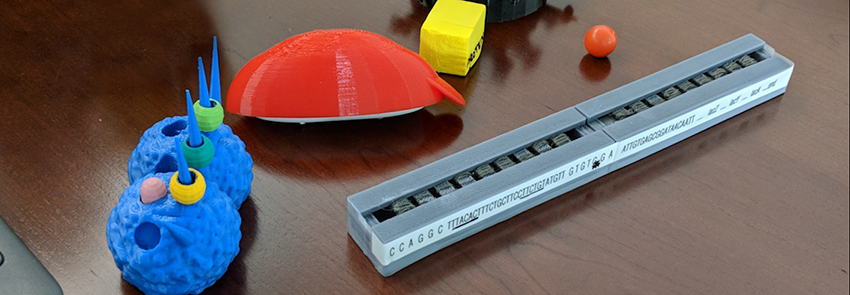
STEM BUILD: Tactile Teaching Tools in Science
NC State University STEM BUILD is an open-source website repository of digital plans and learning activities for tactile teaching tools (primarily 3D printables) in the sciences. These tools can be used to create inclusive learning environments and more effective instruction for all students. Instructors who visit the site have the option to view, use, add, and/or remix tactile teaching tools and lesson plans. The website serves as a central location where 3D files and associated materials and learning activities can be shared and used by college and high school science teachers, connecting the instructor and maker communities at NC State and beyond.
The website will serve as a hub where makers and educators from high school to college levels can build a community around using tactile teaching tools. It will connect those interested in improving their courses with makers who know how to build 3D models, allowing educators who lack the resources or knowledge of 3D design to provide more for their students.
Teaching Assistant Professors Claire Gordy and Melissa Ramirez realized that 3D printed models could be part of the answer to better accessibility and greater understanding for all students. 3D printing is already being used to construct static models of molecules for students to view. Gordy and Ramirez wanted to push beyond that and use 3D models to emulate real-time biological processes. Because the models help to illustrate processes that happen in three dimensions and across time in a way that goes beyond 2D materials, 3D printed models can not only help students with learning differences and visual impairments but also improve learning for all students.
After determining the site’s purpose, audience, structure and functions, DELTA worked with NC State’s OIT Design group to create the website. The STEM BUILD website allows users to share and modify 3D printing files, lesson plans, assessments, lesson instructions, learning outcomes and teaching notes. Next steps for the site will be to add more materials and create a larger community outside of NC State that brings together faculty interested in teaching with these tools with makers who have the skills to develop them.
Instructional Challenges
- Biological processes are most often conveyed with pictures in slideshow presentations or textbooks, which can be challenging for students with diverse needs.
- Pictures capture only a single moment, making it difficult to visualize the entire biological process.
- Creating 3D objects of processes that cannot be observed by the naked eye makes it difficult to translate them into meaningful visual models.
- Making a model that is affordable and replicable. Many models involve electronic, magnetic, moving, and interlocking parts that complicate the design process.
Highlights/Solutions
- 3D printed tactile teaching tools illustrate biological concepts in a way that helps improve learning for all students.
- The models aren’t exact representations of the molecules as they exist in reality, but rather focus on the interactions between them to demonstrate biological processes.
- Different colors and Braille symbols are used for various parts and models.
- Designers used iteration to develop models with the right combination of accuracy, affordability, and replicability.
- The STEM BUILD website will act as an open-source repository of digital plans and learning activities for tactile teaching tools. Instructors who visit the site have the option to view, use, add, and/or remix tactile teaching tools and lesson plans.
- The STEM BUILD will serve as a hub where makers and educators from high school to college levels can build a community around using tactile teaching tool, allowing educators who lack the resources or knowledge of 3D design to provide more for their students.
Related Links
A Work in Progress: Tactile Teaching Tools for Inclusivity in Science Education
For more information about DELTA services, please contact LearnTech.